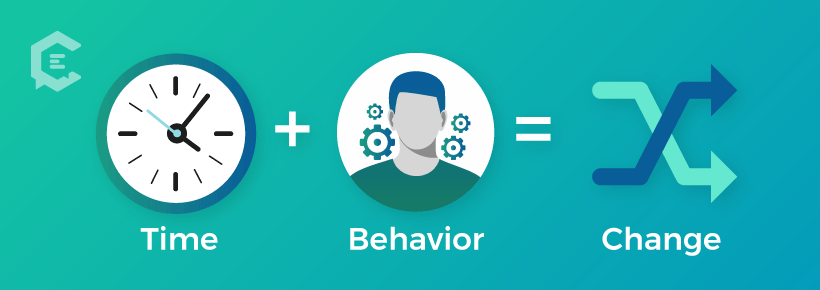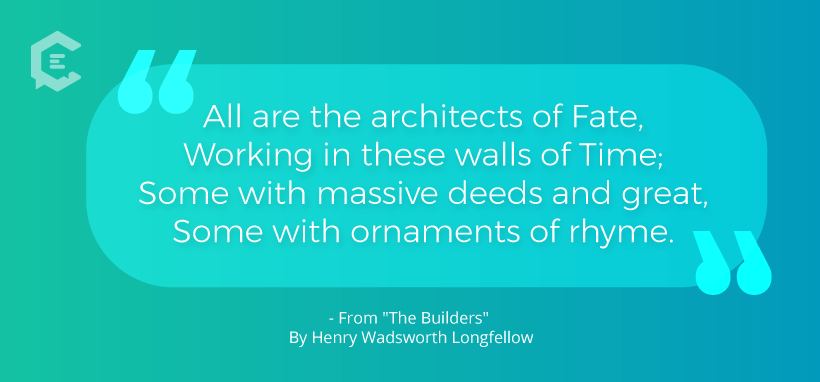Time is all in your head. All of it. In your head. Not even Einstein could definitively put an end to the debate: What is time? So aside from a tangent on the space-time continuum and the enigma of quantum entanglement (ooh, it’s a doozy), let’s get right to it, with a 21st century way of thinking about time management. (And if it doesn’t all make perfect sense the first time, give it a second read while imagining narration by Neil deGrasse Tyson or Morgan Freeman. Works every time.)
The secret to time management: Time is relative
To get a better grasp on time management, you can begin by pushing your thinking beyond the common view that time is linear or absolute. Because it’s neither. While one moment can stand still for one person, it can fly for another; and while we might experience moments in the immediate present as occurring in a linear order, our thoughts can rapidly jump back and forth, past and future, in a nonlinear fashion. So in its most intimate relation to human experience, time is only our relative perception of change, of possibilities that have occurred or that could occur from our viewpoint.
And what’s key to remember is that change — any change — can only happen through a behavior of some kind, whether on the nano scale of atomic interactions or the macro scale of the great animal migrations, or even in the swirl of the Milky Way galaxy. Yet no matter how big or small, the essence of all actions boils down to a simple equation: Time + Behavior = Change.
So time management — the process through which we order our actions — is really behavior management. It’s not just about putting actions on lists and calendars. It’s about understanding the behaviors behind those actions as they relate to time.

Still with me? Good. If you want to unlock a different approach to managing your time, whether personally or in an organizational environment, you can think of time as something beyond when (clock time), what (a resource), or where (a destination). You can think of time in the terms of how, as a behavior or a method of travel. How are you interacting with the flow of time itself? What behaviors in your relationship with time are affecting change and possibility?
Although there are countless tools to track, record, and plan the minutia of time, if you can fully connect with your primal relationships with time, you’ll find it easier to focus on the holistic big picture. To do so, you have to organize your thoughts, actions, and goals into the five primal flows (i.e., fundamental behaviors) we all use every day to manage the abstract of time and create change (action) in our lives. And they are:
- Spontaneous – What can I do now?
- Reactive – What must or should I do?
- Cyclical – What do I do again and again?
- Proactive – What can I plan to do?
- Envisioned – What can I ultimately achieve?
In future posts, I’ll go in depth on content strategies for each behavior and how they fit into greater organizational planning and goals (without too much more on the theoretical physics of time). For now, here’s a primer to help you rethink time as a how — and to help you recognize the methods for traveling within it. It’s a method I’ve called the Time Flow Method.
Using the Time Flow Method: The Five Flows of Time Management
In the paradigm of the time-flow method, the flows range in order of immediacy from spontaneous (the most immediate) to envisioned (the ultimate or least immediate).
Spontaneous
What can I do now?
As our most immediate interaction with time, the spontaneous flow requires no stimuli or force to react to. Our spontaneous behaviors can cause change to happen just because we can at the moment. It’s our most free and independent relationship with time, the flow we have the most control over.
On a personal level… The spontaneous flow often involves unplanned actions that don’t necessarily consider potential outcomes or consequences.
On an organizational level… The spontaneous flow often involves innovation, brainstorming, and a focus on creativity not constrained by standard operations.
Reactive
What must or should I do?
Perhaps our most challenging interaction with time, the reactive flow always requires a response. Our reactive behaviors cause change to happen because we have to or because we are compelled to by external or internal forces. It’s our most entangled relationship with time, the flow we have the least control over.
On an individual level… The reactive flow often involves responding to an external event, whether expected or unexpected, or to an internal need that must be satisfied.
On an organizational level… The reactive flow often involves contingencies for unexpected events and preparedness for events that are expected to happen inevitably but cannot be avoided.
Cyclical
What do I do again and again?
Arguably our most comfortable interaction with time, the cyclical flow always governs repetition and patterns. Our cyclical behaviors can cause change to repeat, whether in an identical fashion or in progressive iterations. It’s our most reliable relationship with time, the flow we can control with a great deal of certainty and predictability.
On an individual level… The cyclical flow often involves your routines and circadian rhythms, as well as your attention to recurring patterns of behavior and stimuli.
On an organizational level… The cyclical flow often involves routines, processes, and efficiencies, as well as an attention to feedback and iterative development.
Proactive
What can I plan to do?
Definitely our most pragmatic interaction with time, the proactive flow encompasses the realm of attainable short-term goals. Our proactive behaviors cause change to happen through planned actions that lead to accomplishments or future events. It’s our most empowering relationship with time, the flow we have the most control over in affecting our near future.
On an individual level… The proactive flow often involves voluntary projects or plans for the near future, those that stand alone or build toward an envisioned goal.
On an organizational level… The proactive flow often involves short-term projects, including independent endeavors or those that might be part of greater, envisioned goals.
Envisioned
What can I ultimately achieve?
Certainly our most elusive interaction with time, the envisioned flow carries our dreams and long-term goals forward. Our envisioned behaviors cause change to happen by directing actions within all the other flows toward a greater achievement or state of being. It’s our most hopeful and passionate relationship with time, the flow we might struggle the most to control and actualize.
On an individual level… The envisioned flow involves fulfilling your greater purpose, meaning, and happiness in life.
On an organizational level… The envisioned flow involves fulfilling an organization’s greater mission, vision, and long-term achievements.
Organizational example of the five flows in time management
Without a doubt, one of the leaders in time management is The Walt Disney Company. So what better example to explore the five flows than the tentative 2019 launch of Star Wars Land (aka Star Wars Galaxy’s Edge) at Disneyland in Anaheim, Calif.? While many outlets might report on various Star Wars Land timelines that give hints at some related events planned in the future, the total amount of planning behind the envisioned project is ginormous. Here is only a small smattering of hypothetical examples within the five flows:
Spontaneous
Transform the ‘Star Wars’ universe into an immersive land at Disneyland. Innovate new rides, test new technologies, and try new processes to make guests experience ‘Star Wars’ in the most enjoyable, memorable ways.
Content possibilities: Create collectible ‘Star Wars’-themed annual passes that have chips to activate exclusive content on special screens in ride queues, or to unlock exclusive, customized online app content via secret “hidden Mickey” in-park sensors. Sync customized content with social apps.
Reactive
Offer exclusive preview days of Star Wars Land to annual pass holders, not only to encourage pass sales and promote early buzz but to react to the demands of avid fans and work out possible fixes or unexpected contingencies before fully opening Star Wars Land to the public.
Content possibilities: In order to dilute crowd densities, set up strategically placed selfie-stations where fans can plant themselves in ‘Star Wars’ scenes (whether physically or digitally green-screened) and socially promote them. Prepare for the overwhelming demand of fans by creating a series of virtual content experiences that fans can experience of the park without physically being in the park.
Cyclical
Devise daily events in Star Wars Land and throughout Disneyland timed to mitigate crowd densities during peak times. Align recurring virtual experiences that guests can participate in while waiting in the anticipated long lines at Star Wars Land. Special note: Disney has created new theme parks and lands so many times, you could consider much of their planning to be cyclical on a grand scale.
Content possibilities: Devise daily Instagram contests for guests in Star Wars Land. Employ ride-specific interactive content for mobile devices, such as ‘Star Wars’ trivia quizzes, that fans can participate while in line in order to win prizes redeemable in the gift-shop exit.
Proactive
Orchestrate the construction of an integrated collection of ‘Star Wars’-themed rides and related entertainment, retail, and food attractions. Collaborate with multiple divisions to align imagineering, marketing, and all areas of fulfillment.
Content possibilities: Align the launch of a new ‘Star Wars’ animated series or game with the launch of the new land, or host a special preview — just for Star Wars Land guests — of the next film in the ‘Star Wars’ universe.
Envisioned
Open Star Wars Land to tremendous fanfare, continue the vision of Disneyland as “the happiest place on earth,” and further Walt Disney’s personal dream: “Disneyland will never be completed. It will continue to grow as long as there is imagination left in the world.”
Content possibilities: Produce a television special for the grand opening that weaves the imagineering of Star Wars Land and the evolution of the ‘Star Wars’ saga into a once-in-a-lifetime Disney celebration, with stars, fans, imagineers, live interactions and, of course, fireworks.
Individual example of the five flows in time management
Buying a home might seem like a single event, but, as any homeowner can attest, it can be a grueling process. The actual conquest of home ownership, like many major life events, can spin our minds into serious time-flow overdrive. Anticipating and managing how the buying process will affect your time and behaviors can help a lot in reducing the tremendous stress involved. It’s a great real-life example to explore time management, with a number of possible examples within the five flows:
Spontaneous
Although buying a home is rarely ever spontaneous, once you’ve decided to become a homeowner, oh, the decision can set off a flurry of spontaneous behaviors: exploring new neighborhoods just on a whim, buying new furniture or decor even before you’re in escrow, having more spur-of-the-moment plans with friends and family you might be leaving, et al. Often the spontaneous flow serves as a much-needed stress-reliever during the home-buying process.
Reactive
Qualifying for a home loan can unload a vicious reactive burden onto anyone, with the scrutiny of your banking records, investments, incomes, credit history, expenditures, taxes, etc. Learning your loan approval amount can dramatically alter the dream home or neighborhood you have in mind. Going through the house hunt, negotiations and escrow also can add countless possibilities for unexpected contingencies. The reactive flow can be intense, but preparing for it can save you time, money and aggravation.
Cyclical
Although saving money for a down payment is the most obvious cyclical behavior, others include repeatedly scanning MLS listings to find the right home or having a checklist to review when viewing a potential home. The cyclical flow also channels a lot of your envisioned flow in regard to your lifestyle in your new home: how long will your commute be, how long will it take to visit friends and family from the new location, how often will certain upkeep be needed on the home, what will your monthly mortgage payment and bills be, et al.
Proactive
Whether you’re moving for a new job, buying a first home to raise a family, downsizing for retirement, or just making an investment, the decision to buy a home is one of the largest proactive endeavors in one’s life — a decision to literally move your life forward. Your proactive behaviors kick into high gear to make it happen: finding a good Realtor, researching neighborhoods or school districts, considering an existing home or new construction, learning local custom or language (if you’re moving afar), taking house-hunting trips, organizing packing and movers, etc.
Envisioned
Of all the primal flows, the envisioned flow is the only one that doesn’t focus on buying a “house”: It focuses on finding a “home.” Where do you see yourself living tomorrow or later down the road? Will it be your dream home or just another step on the property ladder of life? Will it be your happy place? How do you envision living your life there? All of these questions, and more, direct all your other actions in the process.
Infographic: Mastering Time Management
In the future we’ll explore each of the five primal flows of time in depth as they relate to content strategy, creation and distribution. However, you might find this infographic helpful in better visualizing the concepts so you can apply them to your personal or organizational time management.






